The northern liveaboard route takes you to the best dive spots between the south of Luzon Island, the Philippines' largest island and home to the capital, Manila, and the north of Palawan, the finger-shaped island that points down to Borneo.
The main highlights along this route include the Apo Reef, and the world's second largest fleet of sunken WWII shipwrecks lying in Coron Bay in the middle of the Calamian Group of islands.
Cruise itineraries vary, but the key points of interest for divers are:
Anilao Batangas, a long established diving centre and favourite for critter spotters. The shallow sandy area of Secret Bay hosts cuttlefish and nudibranchs, pipe fish and dragonets, seahorses and gurnards. Sunset dives are also on the agenda to see mandarin fish mating. A perfect macro creature spotting site for night dives. Meanwhile at Twin Rocks you can spend hours watching the snappers and jacks as they school about you or, taking a closer look amongst the corals, for frog fish, devil fish, ghost pipefish, nudibranchs, shrimps, ribbon eels, gobies, orang-utan crabs and several species of anemone fish.
The pretty island of Pandan with its white sand beaches and gin clear waters hiding coral gardens with resident turtles and shallow reefs.
The Apo Reef Marine National Park in the South China Sea, one of the best known dive spots in Southeast Asia. Apo Reef offers extraordinary walls and drop offs with fantastic marine life. Dive spots like “Ego wall”, “Alladin” and “Hunters Rock” offer tremendous coral drops with excellent overhangs where schools of grey shark and great barracudas are common. You also see a lot of turtles, whitetip reef sharks and schools of snappers. Apo Reef is home to a turtle colony which is guarded by local rangers.
In the recent years many divers have been experiencing curious hammerhead sharks in the strong current along Apo Reef. Devil ray, great manta and eagle ray are also very common on these locations and are often spotted in large schools. Due to its location far out in the South China Sea, the visibility on Apo Reef is often more than excellent.
Coron Bay has the second largest fleet of sunken Japanese WWI wrecks after Truk (Chuuk) Lagoon in Micronesia, and is particularly good for diving as most are lying in shallow waters.
The history tells us that in September 1944, “taskforce 38” discovered 18 ships, well camouflaged inside Coron bay. These ships belonged to the royal Japanese navy and supported the Japanese ships which participated in the battle of Leyte gulf. More than 180 fighters from among others the aircraft carrier New Jersey participated in the attack.
MOst ships were salvaged by the Japanese alter the attack so engines and other easily retrievable contents were removed making for easy swim throughs. The hulls make excellent habitat for local marine life.
Not the case with the seaplane carrier, Arkitsushima, which lies between 20-38m/ 75-130ft and is a true warship. Loaded with anti-aircraft guns and a large crane there is plenty to explore on the outside of the wreck. Hazards from the sharp ragged metal and deep depth make penetration of the engine room here only for the experienced and qualified wreck divers, however you are rewarded with an impressive sight of the 4 engines. Schools of batfish have made the Arkitsushima their home and large groupers can be also be found here.
Moving around the coast of Busuanga Island, it is also possible to encounter the unique and rare sea cow, the “dugong”.
Topside Coron Bay boasts spectacular limestone cliffs, some with hidden lagoons.
Siren
Diving the wrecks of Coron, Apo Reef and Batangas, Philippines
This diving adventure takes you from the harbour of Coron bay, where numerous wreckages can be explored, via the World Heritage site of Apo reef and onwards to the North of Mindoro Island to dive the muck diving havens of Anilao and Puerto Galera (or vice versa). The dive sites consist of wrecks from World War II, covered with soft and hard corals and home to schooling fish, a fresh water lake, steep reef walls and gentle sandy slopes for a truly varied dive vacation.
Coron Bay and Busuanga
To the far north of Palawan lies the Calamian group of islands, to which Busuanga and Coron are a part. It was here in September 1944 that the battle of Coron Bay took place, in which a US Navy task force attacked a Japanese supply fleet that was at anchor. The rapid, heavy attack began with the sinking of the some largest vessels in the harbour - the armed Arkitsushima and the oil tanker Olympia Maru. Of the 24 ships that were sunk in the bay 12 wrecks are within diveable depths and we spend up to 3 days diving here. In Northern Busuanga we also visit dive sites for a chance to see dugongs that come to feed on the seagrass, whilst inland is Barracuda Lake - a freshwater site offering great visibility within the cave systems and some interesting thermoclines.
Apo Reef
Apo reef, declared a World Heritage site in 2007, is a protected reef that covers an area of 34 square kilometres, made up of 2 reef atolls (Apo Menor and Apo Major) it is the second largest of the World's contiguous reef systems. 33Km from the coast of Mindoro Occidental the reef teems with life. Rocky walls with huge seafans and barrel sponges attract schooling snappers, white tip reef sharks, marble rays and are home to many crustaceans including spiny lobsters. Manta rays and eagle rays are also known visitors to the reefs for cleaning. Whales have also been known to cruise between the islands and can be seen as they break the surface to breathe.
Anilao and Batangas
Just a few hours short journey southwards from Manila, the ports of Batangas, on the south of Luzon Island is a World renown muck diving area. It is whilst diving at Anilao that many new species, particularly nudibranchs, have been discovered. There are also several islands within the Calavite Passage that offer some fantastic diving - with strong currents possible and amazing underwater topography.
Liveaboard Diving Itinerary
The Philippine Siren follows a 10 night itinerary to bring you to these 3 varied diving areas. Trips start in either Coron and culminate in Batangas or vice versa.
Diving Highlights
Arkitsushima - Coron Bay, Busuanga
The Seaplan carrier wreckage lies between 20-38m/ 75-130ft and is a true warship. Loaded with anti-aircraft guns and large crane there is plenty to explore on the outside of the wreck. Hazards from the sharp ragged metal and deep depth make penetration of the engine room only for the experienced and qualified wreck divers- however you are rewarded with an impressive sight of the 4 engines. Schools of batfish have made the Arkitsushima their home and large groupers can be also be found here.
Bahura 29 - Apo Menor
The sloping reef wall is where we are surrounded by schools of surgeonfish, jacks, fusiliers and triggerfish. Whitetip reef sharks scour the reef for prey or can be found resting in the many crevices. Dogtooth tuna cruise by in the deeper waters and lobsters are found hiding along the reef wall, whilst at the surface the action continues as sightings of spinner dolphins and whales are a common occurrence.
Drop Off - Verde Island
Lying in the passage between Luzon and Mindoro, Verde island can be exposed to strong currents that make diving here exhilarating. The pinnacles stretch into the depth from the surface making an ideal dive for all levels. Covered with soft corals and sea fans the sheer reef walls hide frogfish and many crustaceans, banded sea snakes scout out small fish to eat whilst schooling pelagics cruise past. We end the dive in the bubbles created by the volcanic activity of the island.
Twin Rocks - Anilao Batangas
This small diving area of 2 large rocks laying just 1 metre apart forms one of the best sites in Anilao. At a maximum depth of just 15m / 50ft hours can be spent here watching the jacks as they school about you or taking a closer look amongst the corals for frog fish, devil fish, ghost pipefish nudibranchs, shrimps, gobies and several species of anemone fish.
- See more at: http://symbiosis-travel.com/philippines/dive-liveaboards/232/dive-philippines-with-the-philippine-siren/#sthash.CUqubRcs.dpuf
The MV Atlantis Azores
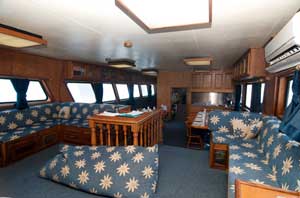 The Atlantis Azores is a 32m, aluminium hulled motor cruiser, built in Louisiana. USA, in 1989 and refitted as a luxury dive boat in 2005.
The Atlantis Azores is a 32m, aluminium hulled motor cruiser, built in Louisiana. USA, in 1989 and refitted as a luxury dive boat in 2005.
SLEEPING
The Azores offers seven deluxe staterooms, each with double and single berths, lavatory and hairdryer, private head and shower, plus one suite on the top deck. 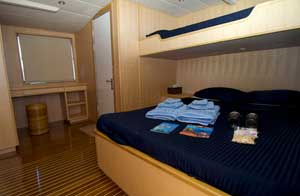 Rooms are serviced daily.
Rooms are serviced daily.
RELAXING
Common areas include a comfortable lounge with library, a selection o board games, playing cards, a flat screen TV and DVD player and a wide selection of movies and marine videos to watch in the evenings.
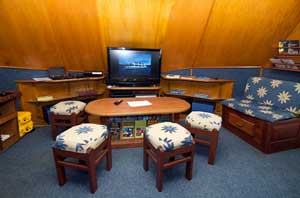 Each evening you will be treated to either one of Atlantis’s unique marine life presentations, a picture slide show or a presentation on your next destination.
Each evening you will be treated to either one of Atlantis’s unique marine life presentations, a picture slide show or a presentation on your next destination.
The Azores features a partially covered sun deck with sun loungers, complete wet bar, hot tub, an assortment of sitting areas with tables, and large swim platform with warm freshwater showers.
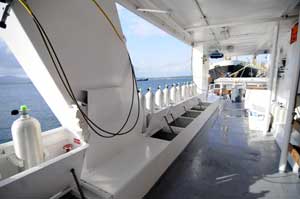 DIVING
DIVING
The Atlantis Azores' spacious dive deck allows divers to gear up in comfort. A roomy three-tier camera table is available for photographers along with a charging station. All divers have their own storage area for dive equipment and there are fresh water showers on the back platform. Most dives are made from two zodiac tender boats with a short ride to dives sites.
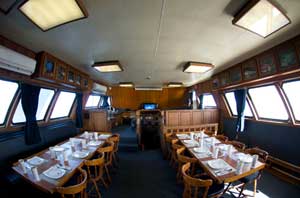 EATING
EATING
Meals aboard the Atlantis are served in the upper deck dining room and feature food from hearty to light, such as “Mom’s soups”, homemade smoked bacon and ham omelettes, mixes from mild to spicy, small to giant beef burgers, fresh garden salads and muesli with yoghurt and fruit. Themed evening meals include ‘Filipino Delights’, the ‘Seafood Dinner, the ‘Carvery Night’, ‘Asian Fusion Cuisine’ and a ‘Best of Four’...
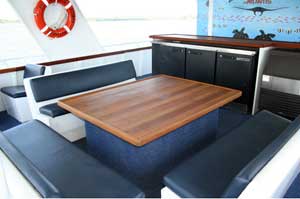 If you are peckish during the day between dive snacks include homemade cookies and cakes, fresh fruit and mouth watering ‘bites’. The complimentary open bar offers:
If you are peckish during the day between dive snacks include homemade cookies and cakes, fresh fruit and mouth watering ‘bites’. The complimentary open bar offers:
- Fresh Blended Juice, Calamansi (local citrus fruit) Juice, Lime Juice, Ice Tea,
- Coffee, Selection of Tea, Milk,
- Filtered drinking water, Coke, Coke Zero, Sprite,
- San Miguel Beer Pale Pilsner, San Miguel Beer Light
- Tanduay Rum (one of the best in the world)
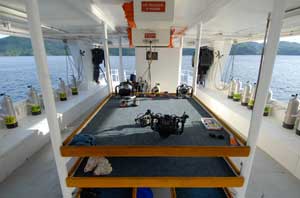 The lunch selection varies between Mongolian Woks, Homemade Pastas and freshly made Panini to order.
The lunch selection varies between Mongolian Woks, Homemade Pastas and freshly made Panini to order.
THE CREW
The Azores' captain and crew are professionally licensed, as required by the law. Dive instructors and Divemasters are trained and certified by national certification agencies.
The crew conduct regular drills and rescue training.
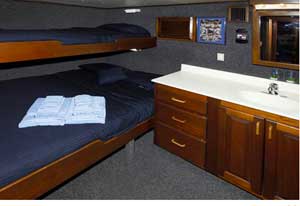 SPECIFICATIONS
SPECIFICATIONS
- Construction: Aluminum Monohull
- Length: 107 feet; Beam: 18 feet; Draft: 7 feet, 1 inch
- Cruising Speed: 10 knots
- Range: 2,500 nautical miles
- Year Built: 1989; Year Refit: 2000/2005
- Builder: Seacraft Shipyard, Amelia, Louisiana
- State Rooms: 8; Passengers: 16; Crew: (6+)
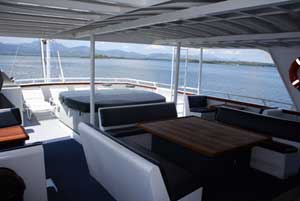 Safety - equipment includes:
Safety - equipment includes:
- First Aid Kit
- Oxygen System with 100% Demand
- Defibrillator
- Automatic Fire Extinguishers & Fire Fighting Equipment
- 406 EPIRB – Emergency Position Indicating Radio Beacons on the mother boat and both zodiacs
- Life Rafts
- Life Jackets with lights and whistles for all passengers and crew
- Full complement of Safety and Rescue equipment.
Navigation and Communication
- Ray Marine E120 Chart-plotter
- 36 mile Color Radar
- Compass
- Video depth sounder
- GPS-Global Positioning System
- VHF radio
- Single Side Band Radio
- Weather facsimile
- Iridium Satellite Phone and computer station
- Internet and Cell Phone coverage possible on some trips
BOUTIQUE
Shop! The Azores Boutique sells some essential dive equipment such as signal tubes, whistles and flashlights, as well as t-shirts, caps and other souvenirs.
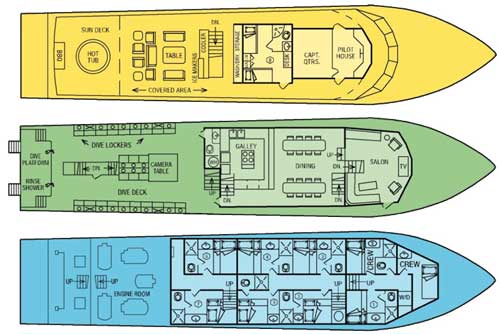
The SY Philippine Siren
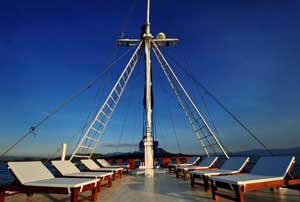 Built on the Indonesian Island of Sulawesi, the 40 metre S/Y Philippine Siren is a traditional “gaft rigged Phinisi” handcrafted from ironwood and teak. The sister ship to the SY Siren, she operates for part of the year in Indonesia and part in the Philippines - a very welcome addition to the fleet in the Philippines.
Built on the Indonesian Island of Sulawesi, the 40 metre S/Y Philippine Siren is a traditional “gaft rigged Phinisi” handcrafted from ironwood and teak. The sister ship to the SY Siren, she operates for part of the year in Indonesia and part in the Philippines - a very welcome addition to the fleet in the Philippines.
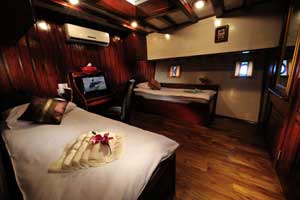 Built by divers for divers, the Philippine Siren is a large boat offering spacious cabins that are can be used as doubles or twins. The expansive dive deck is well equipped for underwater photographers and videographers with designated areas for charging and preparation of camera and video equipment.
Built by divers for divers, the Philippine Siren is a large boat offering spacious cabins that are can be used as doubles or twins. The expansive dive deck is well equipped for underwater photographers and videographers with designated areas for charging and preparation of camera and video equipment.
 You will find no other dive liveaboard as beautiful in Philippine waters, and being that she was and not adapted from being a second hand research vessel, the choice is clear.
You will find no other dive liveaboard as beautiful in Philippine waters, and being that she was and not adapted from being a second hand research vessel, the choice is clear.
The S/Y Philippine Siren accommodates up to 16 guests aboard each trip. This ensures abundant space for all guests.
Features of the S/Y Philippine Siren include:
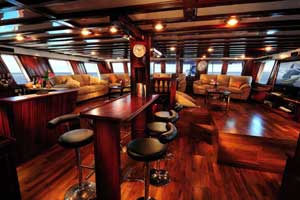 7 sails
7 sails- An expansive leisure deck area
- A spacious air-conditioned saloon with cocktail bar, 42 inch flatscreen & computer server supporting the inter-cabin network
- covered outdoor dining area
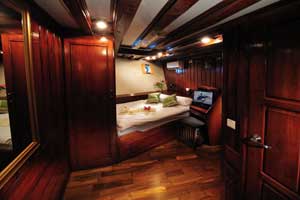 8 large air-conditioned cabins each with their own personal computer, audio-visual entertainment system and ensuite bathrooms with hot water. All rooms are lavished with luxury extra’s including bathrobes, hair dryers, towels, individually controlled mood lighting and individual controls for your air-conditioning unit.
8 large air-conditioned cabins each with their own personal computer, audio-visual entertainment system and ensuite bathrooms with hot water. All rooms are lavished with luxury extra’s including bathrobes, hair dryers, towels, individually controlled mood lighting and individual controls for your air-conditioning unit.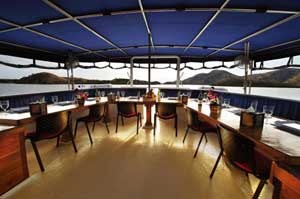 Laundry Service
Laundry Service- Massage Service
- Yacht Boutique, offering merchandise such as towels, hats, log books, t-shirts, shorts and lighters just to name a few items
- Enriched Air Nitrox is free for all certified Nirox divers. If you are not a certified Nitrox diver all our instructors can certainly teach you the Enriched Air Specialty
- 2 high-powered Zodiacs accompany the S/Y Philippine Siren
- Kayaks
Specialized features for Underwater Photographers & Videographers include:
- Each cabin is fitted with an individual computer and multiple power sources to facilitate the needs of digital photography. The computer features high end specifications and 20” high definition flatscreens, which are integrated with the yachts network server in the saloon.
- Workstations for the preparation and maintenance of cameras including prep and storage areas
- Large rinse tanks with fresh water solely for cameras and videos.
S/Y Philippine Siren - Yacht Safety:
The S/Y Philippine Siren has been designed and constructed based upon Lloyds Standards, the leading international body of maritime safety standards. The crew has been specially trained in all aspects of safety, emergency and evacuation procedures. The yacht is equipped with the latest safety features including Life Rafts, Life Jackets, Fire Extinguishers, Smoke Alarms, Emergency Long Distance Radios, and Satellite Phones.
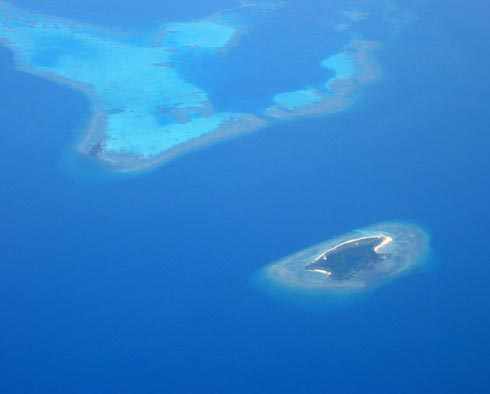

 The Atlantis Azores is a 32m, aluminium hulled motor cruiser, built in Louisiana. USA, in 1989 and refitted as a luxury dive boat in 2005.
The Atlantis Azores is a 32m, aluminium hulled motor cruiser, built in Louisiana. USA, in 1989 and refitted as a luxury dive boat in 2005. Rooms are serviced daily.
Rooms are serviced daily. Each evening you will be treated to either one of Atlantis’s unique marine life presentations, a picture slide show or a presentation on your next destination.
Each evening you will be treated to either one of Atlantis’s unique marine life presentations, a picture slide show or a presentation on your next destination. DIVING
DIVING EATING
EATING If you are peckish during the day between dive snacks include homemade cookies and cakes, fresh fruit and mouth watering ‘bites’. The complimentary open bar offers:
If you are peckish during the day between dive snacks include homemade cookies and cakes, fresh fruit and mouth watering ‘bites’. The complimentary open bar offers: The lunch selection varies between Mongolian Woks, Homemade Pastas and freshly made Panini to order.
The lunch selection varies between Mongolian Woks, Homemade Pastas and freshly made Panini to order. SPECIFICATIONS
SPECIFICATIONS Safety - equipment includes:
Safety - equipment includes:
 Built on the Indonesian Island of Sulawesi, the 40 metre S/Y Philippine Siren is a traditional “gaft rigged Phinisi” handcrafted from ironwood and teak. The sister ship to the SY Siren, she operates for part of the year in Indonesia and part in the Philippines - a very welcome addition to the fleet in the Philippines.
Built on the Indonesian Island of Sulawesi, the 40 metre S/Y Philippine Siren is a traditional “gaft rigged Phinisi” handcrafted from ironwood and teak. The sister ship to the SY Siren, she operates for part of the year in Indonesia and part in the Philippines - a very welcome addition to the fleet in the Philippines. Built by divers for divers, the Philippine Siren is a large boat offering spacious cabins that are can be used as doubles or twins. The expansive dive deck is well equipped for underwater photographers and videographers with designated areas for charging and preparation of camera and video equipment.
Built by divers for divers, the Philippine Siren is a large boat offering spacious cabins that are can be used as doubles or twins. The expansive dive deck is well equipped for underwater photographers and videographers with designated areas for charging and preparation of camera and video equipment. You will find no other dive liveaboard as beautiful in Philippine waters, and being that she was and not adapted from being a second hand research vessel, the choice is clear.
You will find no other dive liveaboard as beautiful in Philippine waters, and being that she was and not adapted from being a second hand research vessel, the choice is clear. 7 sails
7 sails 8 large air-conditioned cabins each with their own personal computer, audio-visual entertainment system and ensuite bathrooms with hot water. All rooms are lavished with luxury extra’s including bathrobes, hair dryers, towels, individually controlled mood lighting and individual controls for your air-conditioning unit.
8 large air-conditioned cabins each with their own personal computer, audio-visual entertainment system and ensuite bathrooms with hot water. All rooms are lavished with luxury extra’s including bathrobes, hair dryers, towels, individually controlled mood lighting and individual controls for your air-conditioning unit. Laundry Service
Laundry Service
